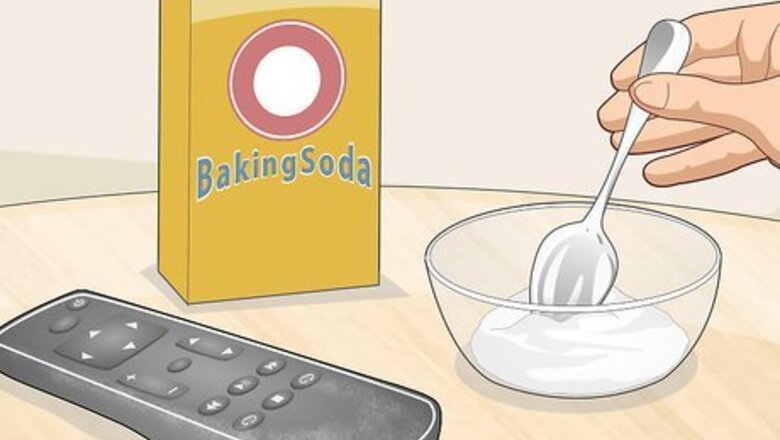
views
Using a Baking Soda Paste
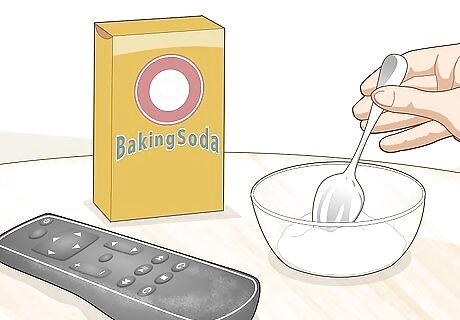
Mix equal parts baking soda and water to form a paste. Put some baking soda in a small bowl, cup, or other container. Add an equal amount of water, then stir the mixture with a spoon until it turns into a paste.Warning: Don’t use this method to clean something like the keys on a plastic keyboard because the paste could get inside easily and damage the electronics. The amount of baking soda and water you need to use depends on how large the plastic item you want to clean is. For example, if it is something small, like a TV remote, you can use about 1 US tbsp (15 mL) of water and 1 tbsp (20 g) of baking soda. This method works to clean a variety of sticky plastic items like plastic kitchen utensils or dishes, TV remotes, plastic containers, toys, and many other types of solid plastic items.
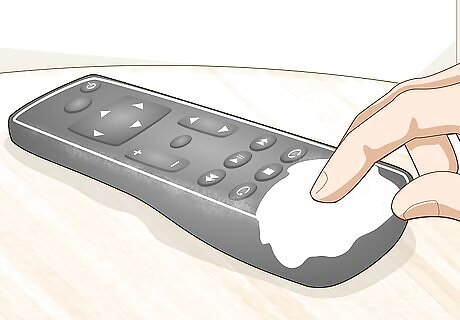
Scrub the paste onto the sticky plastic item with your fingers. Scoop a bit of the paste onto your fingertips and rub it all over the item you want to clean using circular motions. Add more paste as needed until you have covered the whole surface of the sticky item. Don’t use anything abrasive like a scouring pad to scrub the paste onto the item because you could scratch the plastic.
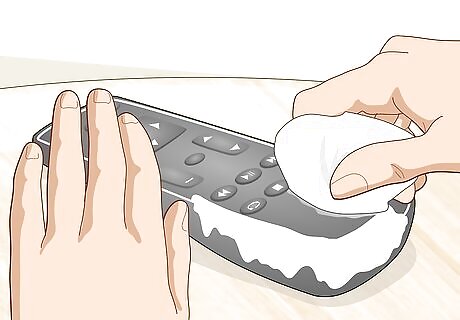
Wipe off the paste with a soft, damp cloth. Moisten a clean, soft cloth with water by holding it under a running faucet until it is soaked, then wring it out so it isn’t dripping. Wipe away all the paste from the plastic item. Rinse out the cloth and repeat as needed until there is no more paste on the plastic. If you are cleaning something with batteries, like a TV remote, make sure to open up and wipe out the battery compartment as well in case any paste got inside. If the item has any cracks or crevices that you can’t wipe the paste out of, you can use something like a toothpick or cotton swab to reach inside them and clean the paste out.

Let the item air dry completely. Set the item in a dry place where it will get plenty of airflow. Wait for it to dry completely before using it. If you wiped out a battery compartment with the damp cloth, make sure you leave the compartment open so it can air dry as well.
Wiping Plastic off with Alcohol
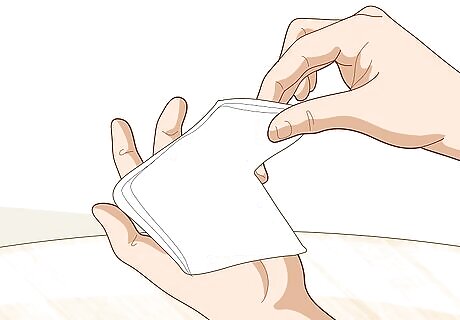
Fold a clean rag into a square or rectangle that fits in your hand. Grab a clean, soft cloth that you don’t mind using to clean. Fold it in half once or twice so it fits neatly in your hand and is easy to work with. If you don’t have a cloth you can use, fold up some paper towels or napkins instead. This method works well to clean off adhesive residue, such as that left behind by stickers or glue. If you are cleaning off an old soft plastic coating that has become sticky, keep in mind that the appearance of the item will likely be shinier and slightly different after you wipe it off with alcohol. However, it won’t be sticky anymore after you remove the deteriorated coating.

Pour some isopropyl alcohol into the middle of the cloth. Hold the cloth face-up in your dominant hand. Quickly tip over the mouth of a bottle of alcohol onto the middle of the cloth to dampen it and tip the bottle back again before too much pours out and soaks the cloth. Note that if you are using this method to clean a plastic item that has crevices or sensitive parts, such as a keyboard, make sure the cloth is just barely damp so no alcohol will drip down into any cracks. Be very careful to just wipe down the non-sensitive plastic surfaces like the tops of the keys on a keyboard. You can also use rubbing alcohol for this, as it contains isopropyl alcohol.

Wipe down the entire sticky plastic surface with the alcohol. Pick up the sticky plastic item in your non-dominant hand and hold it firmly. Rub the alcohol all over the plastic surface to clean it, turning the item in your hand as needed to reach all sides of it.Warning: Keep in mind that alcohol can remove the color from certain types of colored plastic. Test the alcohol out on an inconspicuous area of the item to see if it removes any color before applying it to the entire surface. Scrub firmly in back and forth or circular motions, paying special attention to the areas where the item is most sticky. Alcohol evaporates very quickly, so you don’t need to worry about drying the item off after you clean it.
Washing Plastic with Soap and Water

Make a solution of liquid dish detergent and water in a small container. Squirt 1 US tbsp (15 mL) of mild liquid dish soap into a small bowl, glass, or other container. Fill the container up with warm water and mix the solution together with a spoon until it is foamy. This method works well for delicate plastic items like plastic playing cards, ID or credit cards, or other plastic items that you are worried about damaging the color or coating of.
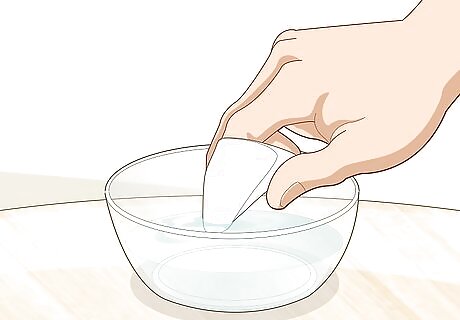
Dip the corner of a clean, soft cloth into the solution. Hold the cloth in your dominant hand with your index finger pointed straight out and a corner of the cloth wrapped around the tip of it. Dip the part of the cloth with your index finger inside it into the soap and water solution quickly and pull it out right away so the cloth doesn’t get too soaked. A microfiber cloth is perfect for this. You could also cut up an old cotton T-shirt into rags and use one of them for this job.
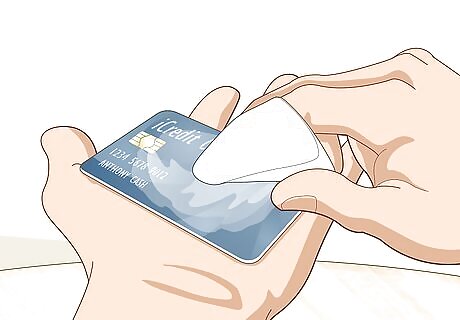
Rub the damp cloth all over the plastic item to clean it. Hold the sticky plastic item in your non-dominant hand. Wipe down the whole item with the damp part of the cloth using back and forth or circular motions, re-wetting it as you go if needed.Tip: If you’re cleaning something flat, like a plastic credit card or ID card, you can lay it on a hard surface like a counter or table and hold it in place with your non-dominant hand while you wipe it off. Make sure to scrub any particularly sticky areas, like where a sticky beverage got spilled on the plastic, until you get all the residue off.
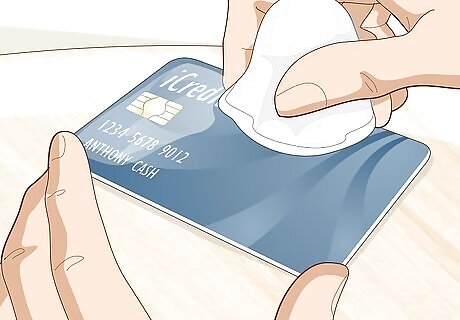
Dry the plastic off completely with a clean dry cloth when you’re done. Grab another soft, clean cloth and wipe off all the excess moisture from the plastic item. Make sure to get in any cracks or crevices that may have accumulated droplets of water. You can use paper towels or napkins if you don’t have a spare dry cloth. Keep in mind they might leave some lint behind.


















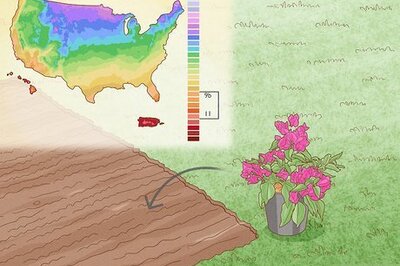
Comments
0 comment